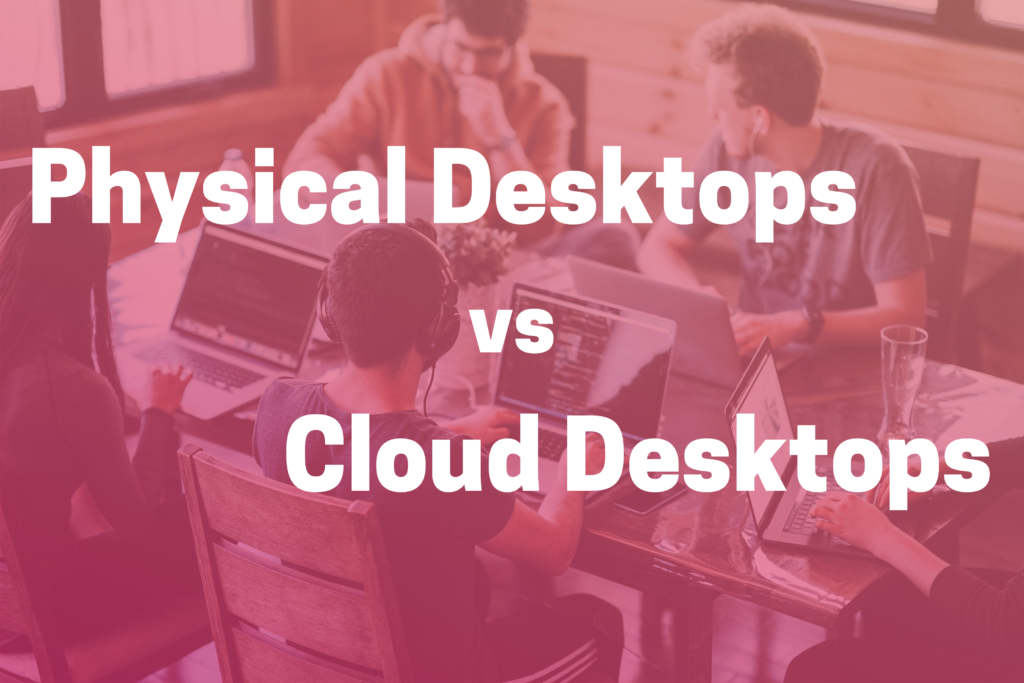Physical desktops vs. cloud desktops

Physical desktops vs. cloud desktops for your company
At the latest after the introduction of Microsoft Virtual Desktop many companies are asking themselves what the advantages and disadvantages of such a technology also known as Cloud Desktop or Desktop-as-a-Service for the company and its employees.
As much as we cloud providers like to claim this, Cloud desktops are not a universal remedy for all needs and applications, but depending on the company and use case, both companies and users also benefit enormously from this.
Cloud desktops benefit both employers and also employees who access the system from outside.
Under the terms “New Work”, “Digital Workplace” or
Work 4.0″ is also understood to mean mobile working regardless of the device, the
location and working hours.
In the USA, according to a study by Forbes, around 50% of US
population at some point during the week from a distance. Many Germans
Companies are also committed to enabling employees to work from home
to offer.
These remote employees often access the system via their private PCs. access company files, or connect via virtual private network (VPN) your home network with the company network. This means that the companies can no longer or only with great difficulty control what data is sent to the network and which data leaves the company network.
The use of cloud desktops enables companies to, more control over the security of their data. The desktop data are stored exclusively in a secure data center. The company has the option of defining security guidelines and protocols, to prevent the data from being transferred to the personal device of persons can be downloaded. Even if the private end device of the employee is stolen, the company does not suffer any damage, since the data in the secure data center.
Comparison of a physical desktop with a cloud Desktop
In many ways, physical desktops and virtual desktops are desktops are identical. They have the same user interface and run the same applications. However, there are also major differences between the two.
- Physical desktops are only located at one Location. The user can only work with the desktop from here.
- Users share a physical desktop so users must be at the desktop when using this.
- Physical desktop support means that companies must have IT technicians on site to resolve problems. The IT technician can only “see” what kind of problem this one has.
- Cloud desktops run in the data center of the providers and are available at any time from any location via any device, PCs, Macs, tablets, smartphones and much more.
- Since cloud desktops are hosted in a data center there is additional physical security and firewalls.
- Cloud desktops can be accessed from a central location be managed. From here you can check whether and which SW which rights may be assigned and whether access is permitted. may.
- If more resources are required, these can be However, they can also be removed again within minutes. For physical desktops, these must first be upgraded in a time-consuming and costly process.
- New cloud desktops can be created within minutes be created. They are generally only charged if they are also used. (pay-as-you-use). The physical desktop always produces Acquisition costs. Although there are also pay-as-you-use payment models here, there are these are nowhere near as flexible as with cloud desktops.
The cost of cloud desktops compared to physical desktops
By migrating to and using cloud desktops instead of
physical desktops, the capital expenditure is transformed into a
operating costs, which is always an advantage in most cases.
Administration is greatly reduced, as the provider is now responsible for the
operation of the Cloud Desktops infrastructure. He also takes care of that,
that sufficient resources are available if required. Support and SW
Maintenance effort is significantly reduced in the centralized environment.
In addition, the cost of the devices used to access the on the virtual desktops through the use of “dumb” terminals and thin clients can be significantly reduced. Especially for home offices most employees already have private end devices, these can also be can be used (BYOD). The employee then e.g. the Internet costs to motivates him much more than a far more expensive one. device, which only costs him additional space.
Factors such as greater security and better Automatically available backup options for cloud desktops should be included in the cost consideration. are also included.
Factors why a migration to cloud desktops fails
Many migration projects fail because they are
users were not accepted. The user experience plays a very important
significant role. New interfaces that are different to use, different environments,
Complex login procedures frustrate users.
However, the projects also fail because the management tools of some cloud desktops
differ fundamentally from those previously used in the company.
Cloud desktop providers are often mainly concerned with their standardized
processes and procedures instead of adapting them individually to the circumstances of the
customers.
Conclusion
Companies can benefit from cloud desktops, especially in the workplace environment. of the future” will benefit considerably. Employees also appreciate (correctly introduced) Cloud Desktops. They offer them, especially from the young generation of employees required flexibility.
But, as is so often the case, good preparation is everything. Fits the
Solution for the company’s use-case? If both the IT
staff and users involved in advance? How reliable is
the cloud desktop provider. Does it meet the data protection requirements applicable in Europe?
All these questions should be clarified and answered in advance.
